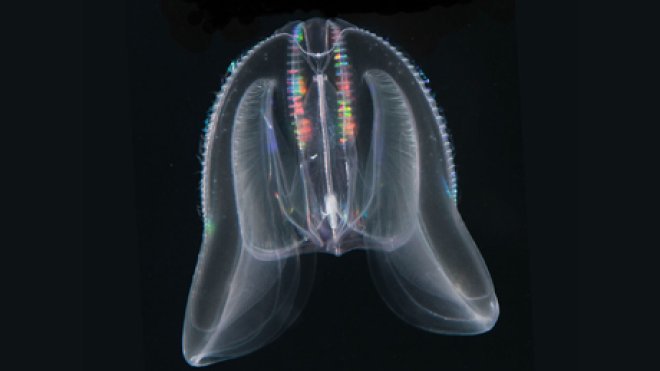The Jellies’ Way: Masters of Stealth Predation
Associate Professor of Environmental Science Sean Colin studies the predatory abilities of comb jellies in calm to rough waters

WOODS HOLE, MASS. – Inside a workshop well-outfitted with microscopes, aquariums and lasers at the Marine Biological Laboratory in Woods Hole, Mass., Sean P. Colin studies the environmental factors that allow the predatory comb jelly Mnemiopsis leidyi to thrive versus merely eke out an existence in the ocean.
With a grant from the National Science Foundation and in collaboration with scientists from two other universities, Colin – an associate professor of environmental science at Roger Williams – intends to answer questions that will help predict why Mnemiopsis invades some waters but not others. When conditions are just right, the diminutive jelly – one of the most efficient and adept feeders on the planet – multiplies by the billions and devours plankton, rupturing the food chain for sea creatures and fishermen alike.
Colin theorizes that these delicate, gelatinous orbs consume considerably less prey in rough waters. A silent predator that can move excruciatingly slowly, Mnemiopsis essentially sneaks up on its prey by hovering on the current. Unsuspecting sightless plankton will swim right up to its mouth, clueless until it’s too late. But when there’s disturbance at the ocean’s surface – the strata that Mnemiopsis like to hunt – the jellies flinch and jet their flimsy bodies below the choppy surface, most likely forgoing feeding at these times.
To understand how and when they feed, Colin has conducted a number of experiments inside the laboratory and out in the sheltered waters of Vineyard Sound to examine the jellies’ reactions in conditions ranging from a glassy surface to the biggest chop.
Watch Colin’s video below illustrating the flow of water around Mnemiopsis – how the current streams unimpeded around the jelly as if there were no creature there. Cool colors like blue and green indicate very low water velocity, while hotter colors – yellow to red to white – show an increase in velocity. As the colors help viewers visualize, there is very little change in water speed at the end of its lobes where the tiny prey enters. The shift in current signaling an animal occurs well inside the jellies’ bell where its sticky lobes snare the plankton for a low-energy-output feast.
The jellies’ masterful stealth predation is more apparent in Colin’s video below of a 3-D look at Mnemiopsis hovering on the current and sitting back to allow copepods – those darting specks that are one of the most difficult ocean prey to catch – to entrap themselves inside its gummy lobes.